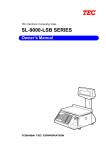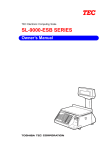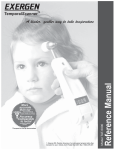Download Radiation detector having improved accuracy
Transcript
Umted States Patent [191 [11] Patent Number: Pompei et a1. [45] [54] RADIATION DETECTOR HAVING 4,636,091 IMPROVED ACCURACY 4,790,324 12/1988 O'Hara et al. . ‘ [75] Date of Patent: 4,797,840 Inventors: Francesco Pompei, Wellesley H1118; _ of Mass‘ [22] Filed: 4,895,164 _ Apr. 14, 1989 May 7, 1991 1/1987 Pompei et a1. . l/1989 Fraden . 4,831,258 5/1989 Paulk et a1. . Philip R. Gaudet, JL, Concord, both [73] Asstgnee: Exergen Corporation, Natlck, Mass. [21] Appl. No.: 338,968 5,012,813 1/1990 Wood ................................ .. 128/736 OTHER PUBLICATIONS ' Y. Houdas and E‘ F‘ J. Ring, Human Body Tempera_ ture, (Plenum Press: New York), p. 83. Primary Examiner-Max Hindenburg Related U.S. Appltcatlon Data Continuation-impart of Ser. No. 280,546, Dec. 6, 1988. Assistant Examiner—-J. P. Lacyk [57] ABSTR AC1. Tympanic temperature measurements are obtained [51] Int. Cl.5 .............................................. .. A61B 6/00 U.S. Cl. .................................. .. 128/664; . 374/130 from the output of a thermopile mounted in an exten Sign from a h0u5ing_ The housing has a temperature display thereon and supports the electronics for re [58] FlEld of Search ..................... .. 128/736, 738, 664; 374/121’ 130431’ “6 sponding to sensed radiation The thermopile is mounted in a highly conductive can which includes a [63] [56] References Cited Us. PATENT DOCUMENTS radiation guide and thermal mass. The guide provides a narrow field of vlew due to a fairly hlgh Cl’?lSSlVlIY. Electronics determine the target temperature as a func 2,7l0.559 6/1955 Heitmuller .................... .. 374/130 X tion of the temperature of the hot junction of [he ther 2,984,747 5/1961 Walker .......................... .. 374/130 X mopile determined from the Cold junction temperature 3,282,106 11/1966 Barnes . d h .] ff. . Th .. 349L596 V1970 Dean _ an at EI'mOPICC'OE 1c1ent._ 358L570 6/1971 wom _ is adjusted to provide an indication-of core temperature. 4,602,642 7/1986 ‘e tympamc temperature O‘Hara et al. . 4,626,686 12/1986 Pompei et a1. . 8 Claims, 7 Drawing Sheets US. Patent m+ +> mwm> uwm mm May 7, 1991 Sheet 3 of 7 5,012,813 US. Patent May 7, 1991 5 HO READ EEPROM |/ INIT Sheet 4 of 7 5,012,813 n2 READ SWITCHES |/ HS "8 4 TEST DISPLAY :20 F] G. 4 A A/D CONVERSION I22 UPDATE TIMERS 4 I24 READ SWITCHES /|2e POWER DOWN |_oor=> RESET I34 / SCAN PROCESS I32 N LOCK LOCK MODE :36 PROCESS 13a N PEAK PEAK MODE 140 _\ |46 PROCESS N / CALCULATE ‘ I44 , MAIN USE TEST MODE OUTPUT I US. Patent Sheet 5 of 7 May 7, 1991 GET SENSOR RAW DATA . / 5,012,813 :48 SUBTRACT SENSOR OFFSET /'50 1 GET T AMBlENT / ‘l CALCULATE TEMPCO I52 /'5 4 ADJUSTMENT MULTIPLY SENSOR SIGNAL BY GAIN a TEMPCO / GET(TAMB|ENT)4 /'58 ADD TO SENSOR SIGNAL I46 / LOOK up 4m ROOT '56 '60 /'62 Y SUBTRACT 32 I64 DIVIDE BY L8 _N ' I A ‘I’ K use ADD ADJUSTMENT VALUE / '68 FIG. 4B CALCULATE OUTPUT PROCEDURE US. Patent ( May 7, 1991 BEGIN Sheet 6 of 7 5,012,813 > I UPDATE TIMER COUNTERS no / F|G 4C 164 / SENSOR coNvEnsmN A/D CONVERSION ? N 186 THERMISTOR / CONVERSION \90 / Y ADJUSTMENT ADJUSTMENT POT CONV BATTERY VOLTAGE CONVERSION / '92 SET '76 IOOMS FLAG / RESET IOOMS FLAG I80 ' / UPDATE DISPLAY A/D CONVERSION lNTERRUPT SERVICE ROUTINE US. Patent May 7, 1991 TEST BEEPER -/ TEST DISPLAY / Sheet 7 of 7 5,012,813 I84 SEGMENTS I TEST DISPLAY DIGITS r READ PUSH BUTTON I86 I88 INCREMENT ____. DISPLAY COUNTER / I92 DISPLAY ADJUSTMENT ---0 DOT VALUE /I94 DISPLAY RAW ‘——-0 SENSOR DATA /|9e DISPLAY AMBIENT ___,, TEMP /I9-8 DISPLAY RAW AMBIENT DISPLAY BATTERY VOLTS __J 1 5,012,813 contact with the can structure. RADIATION DETECTOR HAVING IMPROVED ACCURACY It has been found that a narrow field of view radiation RELATED APPLICATION This is a continuation in part of Application No. 07/280,546 ?led Dec. 6, 1988 pending for “Radiation Detector Suitable for Tympanic Temperature Measure ment” which is incorporated herein by reference. 10 BACKGROUND Radiation detectors which utilize thermopiles to de tect the heat flux from target surfaces have been used in various applications. An indication of the temperature of a target surface may be provided as a function of the measured heat flux. One such application is the testing of electrical equipment. Another application has been in the scanning of cutaneous tissue to locate injured subcu taneous regions. An injury results in increased blood flow which in turn results in a higher surface tempera ture. Yet another application is that of tympanic tem— perature measurement. A tympanic device relies on a measurement of the temperature of the tympanic mem brane area in the ear of an animal or human by detection of infrared radiation as an alternative to traditional sub 2 the unitary thermal mass and which is in close thermal detector provides a more accurate reading of tympanic temperature. In the detector of the present invention, that ?eld of view is obtained by controlling the reflec tance of the surface of the radiation guide, the length of the guide and the position of the thermopile behind the guide. A ?eld of view of less than about sixty degrees allows for viewing of only a portion of the ear canal within about 1.5 centimeters of the tympanic mem brane. Accuracy of the detector may be improved electroni cally as well. Accordingly, an electronic circuit is cou pled to a thermopile, having a cold junction and a hot junction mounted to view a target, and to a temperature sensor for sensing the temperature of the cold junction. The electronic circuit is responsive to the voltage across the thermopile and a temperature sensed by the temperature sensor to determine the temperature of the target. The electronic circuit determines the tempera ture of the target as a function of the temperature of the hot junction of the thermopile determined from the cold junction temperature and a known thermopile coef?ci 25 ent. A display provides an indication of the target tem perature determined by the electronic circuit. As in prior systems, the electronic circuit determines target temperature from the relationship T74=(KH)+T4, where Tris the target temperature, K linqual thermometers. SUMMARY OF THE INVENTION An improved tympanic temperature measurement device is presented in parent Application No. 07/280,546. That device provides for accuracy within is a gain factor, H is a sensed voltage from the thermo pile and T is a junction temperature of the thermopile. In accordance with the present invention in a preferred embodiment, the junction temperature is the tempera ture of the hot junction. The hot junction temperature T]; is determined from the sensed thermopile voltage and cold junction temperature and a thermopile coef? cient. The thermopile coef?cient is speci?ed at a prede termined temperature and is temperature compensated one-tenth of a degree over limited ranges of ambient temperature and accuracy to within one degree over a wide range of ambient temperatures. An object of the present invention is to provide a tympanic temperature measurement device which would provide accuracy to within one-tenth degree over a wide range of ambient temperatures. In obtaining that accuracy, an object of by the electronic circuit as a function of a temperature the invention was to continue to avoid any requirement for a reference target or for control of the temperature between the hot and cold junctions, speci?cally the average temperature. Further, the electronic circuit of the thermopile as such requirements had resulted in determines the gain factor K as a function of the differ complexity and dif?culties in prior tympanic tempera ence between a calibration temperature and a tempera ture measurement devices. A radiation detector comprises a thermopile and a can enclosing the thermopile. The can structure in cludes an elongated radiation guide of a ?rst internal 45 ture between the hot and cold junction temperatures. When used to measure a biological temperature, the radiation detector is further improved by providing an indication of an internal temperature within biological tissue. The electronic circuit determines the internal diameter. The radiation guide extends from a viewing window to a rear volume of larger internal diameter in 50 temperature by adjusting a measured temperature of surface tissue for ambient temperature. In particular, the which the thermopile is mounted. The guide may be biological surface tissue may be tympanic membrane or gold plated. the ear canal adjacent to the membrane, and the display In accordance with one feature of the present inven may provide an indication of core temperature. tion, the portions of the can forming the radiation guide and rear volume are formed in a unitary structure of 55 high thermal conductivity material. The can structure has an outer surface with an outer diameter at its end adjacent to the window which is less than an outer diameter about the rear volume. The outer surface is BRIEF DESCRIPTION OF THE DRAWINGS The foregoing and other objects, features and advan tages of the invention will be apparent from the follow ing more particular description of preferred embodi tapered about the radiation guide such that a unitary 60 ments of the invention, as illustrated in the accompany ing drawings in which like reference characters refer to thermal mass of increasing outer diameter is provided the same parts throughout the different views. The about the end of the radiation guide adajacent to the drawings are not necessarily to scale, emphasis instead rear volume. The unitary can structure maximizes con ductance and thermal mass within a limited diameter. being placed upon illustrating the principles of the in To avoid changes in ?xtures used in mounting the ther 65 vention. mopile within the can, the unitary can of limited diame ter may be supplemented with an additional thermal FIG. 1 illustrates a radiation detector for tympanic temperature measurements in accordance with the pres mass which surrounds the rear volume and a portion of ent invention. 3 5,012,813 FIG. 2 is a cross-sectional view of the extension of the detector of FIG. 1 in which the thermopile radiation sensor is positioned. FIG. 3 is a block diagram of the electronic; circuit of the detector of FIG. 1. - FIGS. 4A-4D are ?ow charts of the system ?rm 4 expense, the window is square with each side slightly longer than the diameter of the radiation guide 32. The window is cemented with epoxy within a counterbore in a ?ange 37 at the end of the radiation guide. The epoxy serves as a gas seal and mechanical support for the somewhat brittle germanium window. The ?ange tympanic temperature measurement. Although the dis serves to protect the germanium window should the detector be dropped. The diagonal of the window is less than the diameter of the counterbore, and its thickness is less than the depth of the counterbore. Therefore, if the detector is dropped, any force which presses the plastic housing toward the window is absorbed by the flange. The germanium need only withstand the forces due to play may be located anywhere on the housing, it is its own inertia. ware. DESCRIPTION OF A PREFERRED EMBODIMENT The radiation detector 12 of FIG. 1 includes a ?at housing 14 with a digital display 16 for displaying a preferred that it be positioned on the end so the user is not inclined to watch it during a measurement. The instrument makes an accurate measurement when ro tated to scan the ear canal, and the user should concen Whereas the detector disclosed in the parent applica tion had a wide ?eld of view of about 120°, it has been determined that a signi?cantly narrower ?eld of view of about sixty degrees or less provides a more accurate indication of tympanic temperature. With a narrower trate on only the scanning motion. Then the display can be read. A thermopile radiation sensor is supported 20 ?eld of view, the thermopile ?ake, when directly view ing the tympanic membrane, also views no more than within a probe 18 at the opposite end of the housing 14. about 1.5 centimeters along the ear canal and preferably The extension 18 extends orthogonally from an interme less than one centimeter. A better view of the tympanic diate extension 20 which extends at an angle of about 15 membrane also results from the cylindrical extension 43 degrees from the housing 14. As such, the head of the beyond the conical portion of the extension 18. With the detector, including the extension 18 and 20, has the ear canal straightened by the probe, the extension 43 appearance of a conventional otoscope. An on/off switch 22 is positioned on the housing. A cross-sectional view of the extension of the detec tor is illustrated in FIG. 2. A base portion 23 is posi can extend well into the ear canal beyond any hair at the canal opening. extension 18 is presented in parent Application No. The tympanic membrane is about 2.5 centimeters from the opening of the ear canal. The conical portion of the extension 18 prevents the tip of the extension from extending more than about eight millimeters into the ear canal. Beyond that depth, the patient suffers noticeable discomfort. With a ?eld of view of about sixty degrees, the ear canal which is about eight milli meters wide is viewed about eight millimeters from the tip of the extension 18. Thus, only the ear canal within about 1.5 centimeters of the tympanic membrane is 07/280,546 and will not be discussed here. The edge at the end of the probe is rounded so that when the probe is inserted into the ear it can be rotated viewed as the radiation guide is directed toward the membrane. The result is a more accurate reading of the tympanic temperature which is closer to core tempera somewhat without discomfort to the patient. The probe ture. tioned within the housing 14, and the housing clamps about a groove 24. As noted, the portion 20 extends at about a 15 degree angle from the housing and thus from the base portion 23. The extension 18 is tapered toward its distal end at 26 so that it may be comfortably posi tioned in the ear to view the tympanic membrane and /or ear canal. A preferred disposable element to be used over the With the present instrument,'the narrow ?eld of view is obtained by two changes to the prior radiation guide. with the ear. By thus rotating the probe, the ear canal is scanned and, at some orientation of the probe during 45 The re?ectivity within the guide is reduced. Radiation entering the tube at greater angles must be re?ected a that scan, one can be assured that the maximum temper greater number of times from the radiation guide before ature is viewed. Since the ear canal cavity leading to the reaching the thermopile ?ake. With-the higher emissiv tympanic area is the area of highest temperature, the ity, such radiation is less likely to reach the ?ake to be instrument is set in a peak detection mode, and the peak detected. The ?eld of view is further decreased by ex detected during the scan is taken as the tympanic tem tending the enlarged rear volume between the ?ake and perature. the radiation guide. Radiation which enters the radia An improved assembly within the extension 18 is tion guide at greater angles, yet travels through the illustrated in FIG. 2. A thermopile 28 is positioned radiation guide, leaves the guide at greater angles and is within a can 30 of high conductivity material such as copper. The conductivity should be greater than two 55 thus unlikely to be viewed by the ?ake. The length of the radiation guide is another parameter which affects watts per centimeter per degree Kelvin. The can is the ?eld of view. By using a planoconvex lens as the ?lled with a gas of low thermal conductivity such as window 35, the ?eld of view can be further limited. Xenon. The thermopile 28 is positioned within a rear Both of the above approaches to decreasing the ?eld volume 31. It is mounted to an assembly which includes of view increase the amount of heat which is absorbed a ?ange 33. The volume is sealed by cold welding of the by the can in which the thermopile is mounted. The ?ange 33 to a ?ange 41 extending from the can. Cold added heat load adds to the importance that the can, welding is the preferred approach to making the seal including the radiation guide, have a large thermal mass and, to utilize past welding ?xtures, the outer diameter and high thermal conductivity as discussed below. of the can is limited. As distinguished from the structure presented in the The thermopile views the tympanic membrane area 65 parent application, the volume 31 surrounding the ther through a radiation guide 32. The radiation guide 32 is mopile and the radiation guide are formed of a single gold plated to minimize oxidation. It is closed at its piece of high conductivity copper. This unitary con forward end by a germanium window 35. To minimize is also curved like an otoscope to avoid interference 5 5,012,813 6 thermopile which is rated to temperatures of 125° C., a struction eliminates any thermal barriers between the low temperature solder of indium-tin alloy which flows foremost end of the radiation guide and the portion of at 100° C. is allowed to ?ow into the annular mass 34 to the can surrounding the thermopile which serves as the cold junction of the thermopile. Further, at least a por tion of added thermal mass which surrounds the radia tion guide is unitary with the can as well. Speci?cally, a taper 39 results in an enlarged region 41 which serves as a thermal mass in accordance with the principals of the provide good thermal coupling between all elements. The thermal resistance from the outer surface of the plastic sleeve 38 to the conductive thermal mass is high to minimize thermal perturbations to the inner thermal mass. To minimize changes in temperature of the guide 32 with any heat transfer to the can which does occur, the thermal mass of the can 30, annular mass 34 and plug parent application. The taper 39 continues along a con ductive thermal mass 34 which surrounds the can and a conductive plug 36. Both the mass 34 and plug 36 are of copper and are in close thermal contact with the can 30. The outer sleeve 38 of the extension 18 and the inter 36 should be large. To minimize thermal gradients where there is some temperature change in the tube during measurement, the thermal resistance between any two points of the thermal mass should be low. Thus, due to the large time constant of the thermal barrier, any external thermal disturbances, such as when mediate extension 20 are of plastic material of low ther mal conductivity. The sleeve 38 is separated from the can 30 and thermal mass 34 by an insulating air space 40. The taper of the can 30 and thermal mass 34 permits the the extension contacts skin, only reach the conductive thermal mass at extremely low levels during a measure insulating space to the end of the extension while mini ment period of a few seconds; due to the large thermal mizing the thermal resistance from the end of the tube 32 to the thermopile, a parameter discussed in detail 20 mass of the material in contact with the cold junction, any such heat transfer only causes small changes in below. The inner surface of the plastic sleeve 38 may be temperature; and due to' the good thermal conductance coated with a good thermal conductor to distribute throughout the thermal mass, any changes in tempera across the entire sleeve any heat received from contact ture are distributed quickly and are re?ected in the cold with the ear. Twenty mils of copper coating would be junction temperature quickly so that they do not affect 25 suitable. temperature readings. In contrast with the prior design, the portion of the The thermal RC time constant for thermal conduc tion through the thermal barrier to the thermal mass and gion 43 of constant outer diameter before a tapered tube should be at least two orders of magnitude greater region 45. The region of constant outer diameter re duces the outer diameter at the distal end and minimizes 30 than the thermal RC time constant for the temperature response of the cold junction to heat transferred to the interference when rotating the extension in the ear to sleeve 38 at the foremost end of extension 18 has a re tube and thermal mass. The RC time constant for con view the tympanic membrane area. The tapered region is spaced six millimeters from the end of the extension to allow penetration of the extension into the ear canal by no more than about eight millimeters. 35 duction through the thermal barrier is made large by the large thermal resistance through the thermal barrier and by the large thermal capacitance of the thermal mass. The RC time constant for response of the cold junction is made low by the low resistance path to the cold junc tion through the highly conductive copper can and warm-up time. This precluded the use a heated target in thermal mass, and the low thermal capacitance of the a chopper unit or heating of the cold junction of the thermopile as was suggested in the O’Hara et al. patent 40 stack of beryllium oxide rings and pin conductors to the One of the design goals of the device was that it always be in proper calibration without requiring a 4,602,642. To accomplish this design goal, it is neces thermopile. sary that the system be able to operate with the thermo pile at any of a wide range of ambient temperatures and that the thermopile output have very low sensitivity to Although the cold junction capacitance is naturally close thermal contact with the can 30. In order that the increasing its size, and the thermal resistance through the longitudinal thermal path through the tube can be decreased by increasing its size. On the other hand, the low, there are s'ize constraints in optimizing the thermal capacitance of the thermal mass, the thermal resistance 45 through the thermal barrier and the internal thermal any thermal perturbations. resistance Speci?cally, the external thermal resistance The output of the thermopile is a function of the can be increased by increased radial dimensions, the difference in temperature between its warm junction, capacitance of the thermal mass can be increased by heated by radiation, and its cold junction which is in hot junction respond only to radiation viewed through the window 35, it is important that the radiation guide size must be limited to permit the extension to be readily positioned and manipulated within the ear. ture as the cold junction. To that end, changes in tem Besides the transfer of heat from the environment, perature in the guide 32 must be held to a minimum, and another significant heat ?ow path to the conductive any such changes should be distributed rapidly to the thermal mass is through leads to the system. To mini cold junction to avoid any thermal gradients. To mini mize heat transfer through that path, the leads are kept mize temperature changes, the tube 32 and the can 30 to small diameters. Further, they are embedded in the are, of course, well insulated by means of the volume of plug 36 through bores 70; thus, any heat brought into air 40. Further, a high conductance thermal path is provided to the cold junction. This conductance is en 60 the system through those leads is quickly distributed throughout the thermal mass, and only small changes in hanced by the unitary construction. Further, the can 30 temperature and small gradients result. is in close thermal communication with the thermal Because the temperature of the thermal mass is not masses 34 and 36, and the high conductivity and thick controlled, and the response of the thermopile 28 is a ness of the thermal masses increase the thermal conduc tance. A high thermal conductivity epoxy, solder or the 65 function of its cold junction temperature, the cold junc tion temperature must be monitored. To that end, a like joins the can and thermal masses. The solder or thermistor is positioned at the end of a central bore 72 in epoxy provides a signi?cant reduction in thermal resis the plug 36. ‘ tance. Where solder is used, to avoid damage to the 32 be, throughout a measurement, at the same tempera 7 5,012,813 8 With transistor TI on, the switch 22 can be used as an A schematic illustration of the electronics in the hous ing 14, for providing a temperature readout on display 16 in response to the signal from the thermopile, is presented in FIG. 3. The system is based on a micro processor 73 which processes software routines in cluded in read only memory within the processor chip. The processor may be a 6805 processor sold by Motor 01a. The voltage generated across the thermopile 28 due input through diode D2 to the microprocessor to initi ate any programmed action of the processor. In addition to the display, the system has a sound output 90 which is driven through the driver 84 by the microprocessor. In order to provide an analog output from the detec tor, a digital-to-analog convertor 92 is provided. When selected by line 94, the convertor converts serial data on line 96 to an analog output made available to a user. to a temperature differential between the hot and cold input to a multiplexer 76. Another input to the multi plexer 76 is a voltage taken from a voltage divider R1, R2 which is indicative of the potential V+ from the Both calibration and characterization data required for processing by the microprocessor may be stored in an electrically erasable programmable read only mem ory (EEPROM) 100. The EEPROM may, for example, be a 93c46 sold by International CMOSgTechnologies, power supply 78. A third input to the multiplexer 76 is Inc. The data may be stored in the EEPROM by the the potential across a thermistor RT1 mounted in the bore 72 of block 36. The thermistor RT1 is coupled in a voltage divider circuit with R3 across a reference po tential VRef. The ?nal input to the multiplexer is a 102. Once stored in the EEPROM, the data is retained even after power down. Thus, though electrically pro junctions is ampli?ed in an operational ampli?er 74. The analog output from the ampli?er 74 is applied as one potential taken from a potentiometer R4 which may be adjusted by a user. The system may be programmed to respond to that input in any of a number of ways. In particular, the potentiometer may be used as a gain control or as a DC offset control. microprocessor when the EEPROM is selected by line grammable, once programmed the EEPROM serves as a virtually nonvolatile memory. Prior to shipment, the EEPROM may be pro grammed through the microprocessor to store calibra tion data for calibrating the thermistor and thermopile. 25 Further, characterization data which de?nes the per At any time during the software routine of the micro processor 73, one of the four inputs may be selected by sonality of the infrared detector may be stored. For example, the same electronics hardware, including the microprocessor 73 and its internal program, may be the select lines 78. The selected analog signal is applied used for a tympanic temperature detector in which the to a multiple slope analog system 80 used by the micro processor in an integrating analog-to-digital conversion 30 output is accurate in the target temperature range of 80. The subsystem 80 may be a TSCSOOA sold by Tele dyne. It utilizes the reference voltage VRef from a reference source 82. The microprocessor 73 responds to the output from the convertor 80 to generate a count 35 indicative of the analog input to the convertor. about 60° F. to a 110° F. or it may be used as an indus trial detector in which the target temperature range would be from about 0° F. to 100° F. Further, different modes of Operation may be programmed into the sys tem. For example, several different uses of the sound The microprocessor drives four 7-segment LED dis plays 82 in a multiplexed fashion. Individual displays are selected sequentially through a column driver 84, and source 90 are available. within each selected display the seven segments are means of an optical communication link which includes a transistor T2 associated with the display. A communi cation boot may be placed over the end of the detector controlled through segment drivers 86. When the switch 22 on the housing is pressed, it closes the circuit from the battery 78 through resistors Proper calibration of the detector is readily deter mined and the EEPROM is readily programmed by during a calibration/characterization procedure. A photodiode in the boot generates a digitally encoded R5 and R6 and diode D1 to ground. The capacitor C1 optical signal which is ?ltered and applied to the detec is quickly charged, and ?eld effect transistor T1 is turned on. Through transistor T1, the V+ potential 45 tor T2 to provide an input to the microprocessor 73. In a reverse direction, the microprocessor, may communi from the storage cell 78 is applied to a voltage regulator cate optically to a detector in the boot by ?ashing spe 86. The regulator 86 provides the regulated +5 volts to ci?c segments of the digital display 82. Through that the system. It also provides a reset signal to the micro communication link, an outside computer 106 can moni processor. The reset signal is low until the +5 volt tor the outputs from the thermistor and thermopile and reference is available and thus holds the microprocessor perform a calibration of the devices. A unit to be cali in a reset state. When the + 5 volts is available, the reset brated is pointed at each of two black body radiation signal goes high, and the microprocessor begins its pro sources while the microprocessor 73 converts the sig grammed routine. nals and sends the values to the external computer. The When the switch 22 is released, it opens its circuit, but a charge is maintained on capacitor C1 to keep transis 55 computer is provided with the actual black body tem peratures and ambient temperature in the controlled tor TI on. Thus, the system continues to operate. How environment of the detector, computes calibration vari ever, the capacitor C1 and transistor T1 provide a very simple watchdog circuit. Periodically, the microproces sor applies a signal through driver 84 to the capacitor C1 to recharge the capacitor and thus keep the transis tor TI on. If the microprocessor should fail to continue ables and returns those variable to be stored in the de tector EEPROM. Similarly, data which characterizes a particular radiation detector may be communicated to the microprocessor for storage in the EEPROM. A switch 108 is positioned behind a hole 110 (F IG. 1) its programmed routine, it fails to charge the capacitor C1 within a predetermined time during which the in the radiation detector so that it may be actuated by a charge on C1 leaks to a level at which transistor T1 rigid metal wire or pin. Through that switch, the user turns off. Thus, the microprocessor must continue in its 65 may control some speci?c mode of operation such as converting the detector from degrees Fahrenheit to programmed routine or the system shuts down. This prevents spurious readings when the processor is not degrees Centigrade. That mode of operation may be operating properly. stored by the microprocessor 73 in the EEPROM so 5,012,813 9 10 that the detector continues to operate in a speci?c mode until a change is indicated by closing the switch 108. A switch 106 may be provided either internally or ‘ perature of the thermopile. The Seebeck coefficient can be determined from the relationship (4) through the housing to the user to set a mode of opera T — Tc tion of the detector. By positioning the switch at either the lock position, the scan position or a neutral position, any of three modes may be selected. The ?rst mode is the normal scan mode where the display is updated continuously. A second mode is a lock mode where the display locks after a selectable delay and then remains frozen until power is cycled or, optionally, the power tion temperature. Again, it can be seen that temperature compensation is based on the average thermopile tem am = (1,;(1- Tco — T5 where a“ is the speci?ed Seebeck coefficient at a partic ular speci?cation temperature and T5 is that speci?ca on button is pushed. The sound source may be caused to perature rather than just the cold junction temperature. sound at the time of lock. The third mode is the peak mode where the display reads the maximum value found since power-on until power is cycled or, option ing for T3, the hot junction temperature is found to be ally, the power-on button is pushed. The processor determines when the voltage from the divider R1, R2 drops below each of two thresholds. Below the higher threshold, the processor periodically The actual sensor output Vs can be determined from the digital value available to the processor from the enables the sound source to indicate that the battery is low and should be replaced but allows continued read out from the display. Below the lower threshold, the processor determines that any output would be unreli able and no longer displays temperature readings. The unit would then shut down upon release of the power button. In the present system, the target temperature is com puted from the relationship T7"—Kh(H-H,,)+ TH‘ (1) By substituting equation (4) into equation (3) and solv equation: KAD (6) Vs = (H — H») '51:? where KA D is the analog-to-digital conversion factor in volts/bit and GFE is the gain of the front end ampli?er. Reference to the hot junction temperature rather than the cold junction temperature in each term of the rela tionship for determining the target temperature pro vides for much greater accuracy over a wide range of ambient temperatures and/or target temperatures. To provide a temperature readout, the microproces where Tris the target temperature, Kh is a gain calibra sor makes the following computations: First the signal tion factor, H is the radiation sensor signal which is from thermistor RTl is converted to temperature using offset by H, such that (H—H0)—O when the target is at the cold junction temperature of the device to counter 35 a linear approximation. Temperature is defined by a set of linear equations any electronic offsets in the system, and TH is the hot junction temperature. This relationship differs from that previously used in that Kh is temperature compensated relative to the average temperature of the thermopile rather than the cold junction, or ambient, temperature. Further, the hot junction temperature rather than the cold junction temperature is referenced in the relation ship. The gain calibration factor Kh is temperature com pensated by the relationship where x is an input and x0 is an input end point of a straight line approximation. The values of M, x0 and b are stored in the EEPROM after calibration. Thus, to obtain a temperature reading from the thermistor, the microprocessor determines from the values of x0 the 45 line segment in which the temperature falls and then performs the computation for y based on the variables M and b stored in the EEPROM. The hot junction temperature is computed. A fourth power representation of the hot junction temperature is then obtained by a lookup table in the processor ROM. where G is an empirically determined gain in the sys tem, Tco is the temperature coefficient of the Seebeck coefficient of the thermopile and T2 is the temperature at which the instrument was calibrated. The use of the The sensed radiation may be corrected using the gain calibration factor Kh, the sensor gain temperature coef ficient Tco, the average of the hot and cold junction temperatures and a calibration temperature Tz stored in average temperature of the thermopile rather than the 55 the EEPROM. The corrected radiation signal and the fourth power of the hot junction temperature are summed, and the fourth root is taken. The fourth root calculation is also based on a linear approximation cantly different from the ambient temperature. which is selected according to the temperature range of As noted, the relationship by which the target tem interest for a particular unit. Again, the break points and 60 perature is determined includes the hot junction temper coefficients for each linear approximation are stored in ature as the second term rather than the cold junction cold junction temperature provides for a much more accurate response where a target temperature is signi? the EEPROM and are selected as required. An additional factor based on ambient temperature may also be included as an adjustment. The temperature (3) 65 of the ear Te which is sensed by the thermopile is not temperature. Hot junction temperature is computed from the relationship "i=1 HIM TH— TC) where JN is the number of junctions in the thermopile actually the core temperature T". There is thermal resistance between TC, and Te. Further, there is thermal and am, is the Seebeck coefficient at the average tem resistance between the sensed ear temperature and the 11 5,012,813 12 ambient temperature. The result is a sense temperature Te which is a function of the core temperature of inter est and the ambient temperature. Based on an assumed constant Kc which is a measure of the thermal resis tances between Tcr, Te and Ta, core temperature can be computed as Beep at button push in lock mode none/20/40/80 milliseconds long Beep at lock none/20/40/ 80 milliseconds long Beep at power down none/20/40/80 milliseconds long Beep at low battery none/20/4-0/80 milliseconds long Te _ Ta interval l/2/3 sec Tcr = Ta + T single/double beep This computation can account for a difference of from one-half to one degree between core temperature and sensed ear temperature, depending on ambient tempera ture. A similar compensation can be made in other applica tions. For example, in differential cutaneous tempera ture scanning, the signi?cance of a given differential reading may be ambient temperature dependent. The actual computations performed by the processor Timeout functions: .5 to 128 sec in .5 sec increments Delay until lock .5 to 128 sec in .5 sec increments 20 Other functions: Power-on button resets lock cycle Power-on button resets peak detect are as follows, where: H is the digital value of radiation signal presented to Display degrees C / degrees F the processor H0 is the electronic offset He is corrected H (deg K4) Tc is ambient and cold junction temperature (deg F) Taf is 4th power of Tamb (deg K4) Tt is target temperature (deg F) T2 is ambient temp during cal (deg F) Td is the displayed temperature Time to power-down 15 25 EEPROM “Calibrated” pattern to indicate that the device has been calibrated EEPROM checksum for a self-check by the proces sor FIGS. 4A-4D provide a flowchart of the ?rmware stored in the microprocessor 73. From reset when the instrument is turned on, the system is initialized at and Rt is the thermistor signal the contents of the EEPROM are read into memory in Kh is a radiation sensor gain cal factor _Zt is a thermistor zero cal factor the microprocessor at 112. At 114, the processor reads the state of power and mode switches in the system. At Th is the hot junction temperature 116, the system determines whether a mode switch 113 (1,; is the Seebeck coefficient of the thermopile at a 35 has placed the system in a self test mode. If not, all speci?ed temperature eights are displayed on the four-digit display 82 for a .1’ is the number of junctions in the thermopile brief time. At 120, the system performs all A-to-D con Tco is a temperature coefficient for the Seebeck coef Ts is the temperature at which a“ is speci?ed versions to obtain digital representations of the thermo pile output and the potentiometer settings through mul 40 tiplexor 76. The system then enters a loop in which Tcr is core temperature kc is a constant for computing core temperature outputs dictated by the mode switch are maintained. First the timers are updated at 122 and the switches are again read at 124. When the power is switched off, from V5 is the sensor output voltage GFE is the gain of thefront end ampli?er KAD is the analog-to-digital conversion factor 126 the system enters a power down loop at 128 until the system is fully down. At 130, the mode switch is checked and if changed the system is reset Although not in the tympanic temperature detector, some detec Tc(deg F)=Thermistor lookup table (Rt)—Zt tors have a mode switch available to the user so that the co) X [(Tco((Tc >< Ts) - (Tcz/ 2)) + Tc + (Vs/ J X (15mm /Tco 50 mode of operation can be changed within a loop. At 132, 136 and 140, the system determines its mode of operation and enters the appropriate scan process 134, lock process 138 or peak process 142. In a scan Thf(deg K‘)=4th power lookup table (Tc) Tt(deg F)=(Hc+ThO5(Final lookup table) Tcr = Te + (Tt - Te)/kc Tt(deg C)=(5/9)><(Tf(deg F)—32) optional The following is a list of the information which may be contained in the EEPROM and therefore be pro grammable at the time of calibration: Radiation sensor offset Radiation sensor gain Radiation sensor temperature coef?cient Thermistor offset Ambient temperature at calibration Thermistor lookup table Final temperature lookup table Adjustment factor F Sound source functions: process, the system updates the output to the current reading in each loop. In a lock process, the system up 55 dates the output but locks onto an output after some period of time. In the peak process, the system output is the highest indication noted during a scan. In each of these processes, the system may respond to the pro gramming from the EEPROM to perform any number of functions as discussed above. In the peak process which is selected for the tympanic temperature mea surement, the system locks onto a peak measurement after a preset period of time. During assembly, the sys tem may be set at a test mode 144 which will be de 65 scribed with respect to FIG. 4D. In any of the above-mentioned modes, an output is calculated at 146. Then the system loops back to step 122. The calculation 146 ‘is illustrated in FIG. 4B. 5,012,813 13 14 a thermopile having a hot junction and a cold junc tion, the hot junction being mounted to view a At 148 in FIG. 4B, the raw sensor data is obtained from memory. The sensor offset taken from the EE target; PROM is subtracted at 150, and the ambient tempera a temperature sensor for sensing the temperature of ture previously obtained from the potentiometer RTl is accessed at 152. The temperature coefficient adjustment 5 is calculated at 154. At 156, the sensed signal is multi plied by the gain from EEPROM and by the tempera an electronic circuit coupled to the thermopile and responsive to the voltage across the thermopile and ture coefficient. At 158, the fourth power of the ambient temperature is obtained, and at 160 it is added to the sensor signal. At 162, the fourth root of the sum is ob 10 determine the temperature of the target, the elec tronic circuit determining the temperature of the tained through a lookup table. Whether the display is in degrees centigrade or degrees Fahrenheit is determined at 164. If in degrees centigrade, a conversion is per formed at 166. At 168, adjustment values, including that 15 from the'potentiometer R4, are added. mopile and the temperature of the hot junction of the thermopile determined from the cold junction temperature and a thermopile coefficient; and Analog-to-Digital conversion is performed periodi the cold junction; a temperature sensed by‘the temperature sensor to target as a function of the voltage across the ther a display for displaying an indication of the tempera ture of the target determined -by the electronic circuit. cally during an interrupt to the loop'of FIG. 4A which ' 2. A radiation detector as claimed in claim 1 wherein occurs every two milliseconds. The interrupt routine is illustrated in FIG. 4C. Timer counters are updated at 170. A-to-D conversions are made from 172 only every 100 milliseconds when a flag has been set in the prior the electronic circuit determines target temperature from the relationship T74=(KhH)+TH4 where T7 is the target temperature, Kh is a gain factor, H is a sensed voltage from the thermopile and T5 is the hot junction temperature of the thermopile. interrupt cycle. During most interrupts, an A/D con version does not occur. Then, the 100-millisecond 3. A radiation detector as claimed in claim 2 wherein counter is checked at 174, and if the count has expired, a flag is set‘at 176 for the next interrupt. The flag is the electronic circuit determines the hot junction tem perature TH from the sensed voltage and cold junction temperature and a thermopile coefficient which is speci ?ed at a predetermined temperature, the thermopile coefficient being temperature compensated by the elec checked at 178 and, if found, the display is updated at 180. The system then returns to the main loop of FIG. 4A. Where the I00 millisecond flag is noted at 172, an 30 tronic circuit as a function of a temperature between the A-to-D conversion is to be performed. The system ?rst hot and cold junctions. determines at 182 whether a count indicates there 4. A radiation detector as claimed in claim 3 wherein the electronic circuit determines the gain factor Kh as a should be a conversion of the thermopile output at 184 or a'conversion of the the thermistor output at 186. The thermopile sensor conversion is performed nine out of function of the difference between a calibration temper~ ature and a temperature beiween the hot and cold junc ten cycles through the conversion loop. At 188, the tion temperatures. system checks to determine whether a conversion is 5. A radiation detector as claimed in claim 2 wherein the electronic circuit determines the gain factor Kh as a function of the difference between a calibration temper ature and a temperature between the hot and cold junc made from the potentiometer R4 or from the battery voltage divider R1, R2 at 192. These conversions are made alternately. FIG. 4D illustrates the self-test sequence which is tion temperatures. called by the mode switch 113 only during assembly. 6. A radiation detector as claimed in claim 1 wherein During the test, the beeper sounds at 182 and all display segments are displayed at 184. Then the system steps each character of the display from zero through nine at the electronic circuit determines the target temperature from the relationship T74=(Khl-I)+T where Tris the target temperature, H is a sensed voltage from the ther mopile, T is a temperature of the thermopile and Kh is a gain factor which is a function of the difference be 186. The system then enters a test loop. At 188, the system senses whether the button 108 has been pressed. If so, a display counter is incremented at 190. The dis tween a calibration temperature and a temperature be play for the unit then depends on the count of the dis tween the hot and cold junction temperatures. play counter. With the zero count, the adjustment po 50 7. A radiation detector comprising: a thermopile mounted to view a target of biological tentiometer value is displayed at 192. Thereafter, if the display counter is incremented by pressing the button surface tissue; a temperature sensor for sensing ambient tempera 108, the raw sensor data is displayed. With the next increment, ambient temperature is displayed at 196, and ture; ‘ ' increment, the battery voltage is displayed. After the an electronic circuit coupled to the thermopile and temperature sensor and responsive to the voltage across the thermopile and the temperature sensed test, the assembler sets the mode switch to the proper by the sensor to provide an indication of an internal with the next increment, the raw output from the ambi 55 ent temperature sensor RTl is displayed. With the next operating mode. While this invention has been particularly shown and temperature within the biological tissue adjusted for the ambient temperature to which the surface tissue is exposed; and described with references to preferred embodiments a display for providing an indication of the internal thereof, it will be understood by those skilled in the art temperature. that various changes in form and details may be made 8. A radiation detector as claimed in claim 7 wherein therein without departing from the spirit and scope of 65 the biological surface tissue is tympanic membrane and the invention as de?ned by the appended claims. the display provides an indication of core temperature. We claim: . it it 4 ‘I l 1. A radiation detector comprising: 60 US005012813C1 (12) EX PARTE REEXAMINATION CERTIFICATE (5745th) United States Patent (10) Number: Pompei et al. (45) Certi?cate Issued: (54) RADIATION DETECTOR HAVING IMPROVED ACCURACY (75) Inventors: Francesco Pompei, Wellesley Hills, MA (US); Philip R. Gaudet, Jr., Concord, MA (US) (73) Assignee: Exergen Corporation, Natick, MA (Us) Reexamination Request: No. 90/007,948, Feb. 27, 2006 US 5,012,813 C1 Apr. 24, 2007 FOREIGN PATENT DOCUMENTS DE EP EP EP EP GB GB JP JP W0 W0 W0 19 14 468 0 092 535 0 201 790 0 447 455 0 763 349 1 226 540 1 425 765 55-11597 58-88627 WO 90/06090 WO 98/08431 WO 00/16051 B1 B1 B1 B1 4/1976 4/1982 5/1985 5/1997 8/2002 12/1967 5/1973 1/1980 5/1983 6/1990 3/1998 3/2000 Reexamination Certi?cate for: Patent No.: 5,012,813 Issued: Appl. No.: Filed: May 7, 1991 07/338,968 Apr. 14, 1989 Related US. Application Data (63) Continuation-in-paIt of application No. 07/280,546, ?led on Dec. 6, 1988, now Pat. No. 4,993,419. (51) “Noncontact Temperature Sensing With Thin Film Thermo pile Detectors,” by Conrad Hamel, Sensors, pp. 29*31 (Jan. 1 989). “Standard Speci?cation for Infrared Thermometers for Inter mittent Determination of Patient Temperature,” American Societyfor Testing and Materials, Designation E l965i98, pp. 1416 (1998). Int. Cl. A61B 6/00 G01] 5/00 (52) (58) OTHER PUBLICATIONS (2006.01) (2006.01) “The Equine Infrared Thermographic Scanner: Assuring Performance of the Equine Athlete . . . at the Speed of Light,” Equine Infrared, by Marybeth Ryan. US. Cl. ...................................... .. 600/474; 374/130 (Continued) Field of Classi?cation Search ..................... .. None See application ?le for complete search history. (56) References Cited Primary ExamineriBeverly M. Flanagan (57) ABSTRACT U.S. PATENT DOCUMENTS Tympanic temperature measurements are obtained from the 2,658,390 3,273,395 3,374,354 3,777,568 3,781,837 3,878,836 3,933,045 3,949,740 4,005,605 4,062,239 4,302,971 A A A A A A A A A A A 11/1953 9/1966 3/1968 12/1973 12/1973 4/1975 1/1976 4/ 1976 2/1977 12/1977 12/1981 Machler Schwarz Hood Risign et a1. Anderson et a1. Twentier Fox et a1. Twentier Michael Fowler et a1. Luk (Continued) output of a thermopile mounted in an extension from a housing. The housing has a temperature display thereon and supports the electronics for responding to sensed radiation. The thermopile is mounted in a highly conductive can Which includes a radiation guide and thermal mass. The guide provides a narroW ?eld of vieW due to a fairly high emis sivity. Electronics determine the target temperature as a ?mction of the temperature of the hot junction of the thermopile determined from the cold junction temperature and a thermopile coefficient. The tympanic temperature is adjusted to provide an indication of core temperature. US 5,012,813 C1 Page 2 US. PATENT DOCUMENTS 4,317,998 A 4,456,390 A 4,566,808 A 3/1982 Dore 6/1984 Junkert et a1. 1/1986 Pompei et a1. 4,614,442 A 9/1986 Poncy 4,634,294 4,662,360 4,684,018 4,722,612 4,784,149 4,854,730 4,895,164 4,907,895 A A A A A A A A 1/1987 5/1987 8/1987 2/1988 11/1988 8/1989 1/1990 3/1990 4,932,789 4,993,419 5,018,872 5,199,436 A A A A 6/1990 2/1991 5/1991 4/1993 5,293,877 A 5,325,863 5,381,796 5,445,158 5,653,238 6,047,205 6,292,685 2002/0026119 A A A A A B1 A1 Christol et a1. O’Hara et a1. Jarund Junkert et a1. Berman et a1. Fraden Wood Everest Egawa et a1. Pompei et a1. SusZynski et a1. Pompei et a1. Det Tronics advertisement, Intech, p. 48, Oct. 1987. Exergen Product Speci?cation for “MicroScannerTM E AutoZero”. FirstTempTM Intelligent Medical Systems, Operation Manual, Model 2000A, pp. 147, Undated. Omega Medical Product Speci?cation for Surface Tempera ture Scanner STSil00iF/C & 101$, by Omega Medical Product Corporation. User Manual for “Surface Temperature Scanner STS*10(%F/C & 1014C”, by Omega Medical Corporation. “Application of PieZo/Pyroelectric Films In Medical Trans ducers,” Jacob Fraden, Journal of Clinical Engineering, Mar/Apr. 1988, pp. 1334138. Dexter Research Center product description for the Model 1M Thermopile Detector, Oct. 1980. 3/1994 O’Hara et a1. Ear Thermometry, Joseph Looney, Jr. & Francesco Pompei, 7/1994 1/1995 8/1995 8/1997 4/2000 9/2001 2/2002 Medical Electronics, Jun. 1989. Proceedings of the Eighth Annual Conference of the IEEE/ Pompei Pompei Pompei Pompei Pompei Pompei Pompei OTHER PUBLICATIONS Engineering in Medicine and Biology Society, Nov. 7410, 1986, vol. 3 of 3, pp. 160641608. Settlement Negotiation Opinion prepared by Counsel for Thermoscan. Exergen Corporation Product Advertisement for “Exergen EHS Infrared Scanner”. J. Love, Annals, NY Academy of Sciences, pp. 4294437 Applicant’s Sketch of “DermaiThermo?raph” device manufactured by IRQNICS Corp. and sold by Dermatherm (1980). Corporation. “Thermography as an Indicator of Blood Perfusion,” by Tom US 5,012,813 C1 1 EX PARTE REEXAMINATION CERTIFICATE ISSUED UNDER 35 U.S.C. 307 2 Where TT is the target temperature, Kh is a gain calibration factor, H is the radiation sensor signal Which is offset by HO such that [(H—HO)—0] (H—HO)=O When the target is at the cold junction temperature of the device to counter any electronic o?‘sets in the system, and TH is the hot junction THE PATENT IS HEREBY AMENDED AS INDICATED BELOW. temperature. This relationship diiTers from that previously used in that Kh is temperature compensated relative to the average temperature of the thermopile rather than the cold Matter enclosed in heavy brackets [ ] appeared in the patent, but has been deleted and is no longer a part of the patent; matter printed in italics indicates additions made to the patent. junction, or ambient, temperature. Further, the hot junction temperature rather than the cold junction temperature is referenced in the relationship. ONLY THOSE PARAGRAPHS OF THE SPECIFICATION AFFECTED BY AMENDMENT ARE PRINTED HEREIN. AS A RESULT OF REEXAMINATION, IT HAS BEEN DETERMINED THAT: Column 9, lines 2743: In the present system, the target temperature is computed from the relationship The patentability of claims 1*8 is con?rmed. 20




















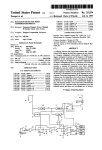


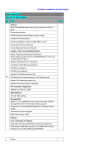
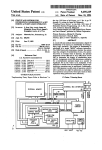
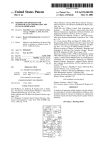
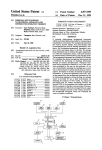

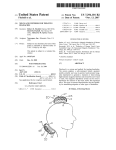

![United StiltBS Patent [19] [11] Patent Number: 5,025,556](http://vs1.manualzilla.com/store/data/006008181_1-2c5f49b6565f7d3a6ea1501cb683eb1f-150x150.png)

